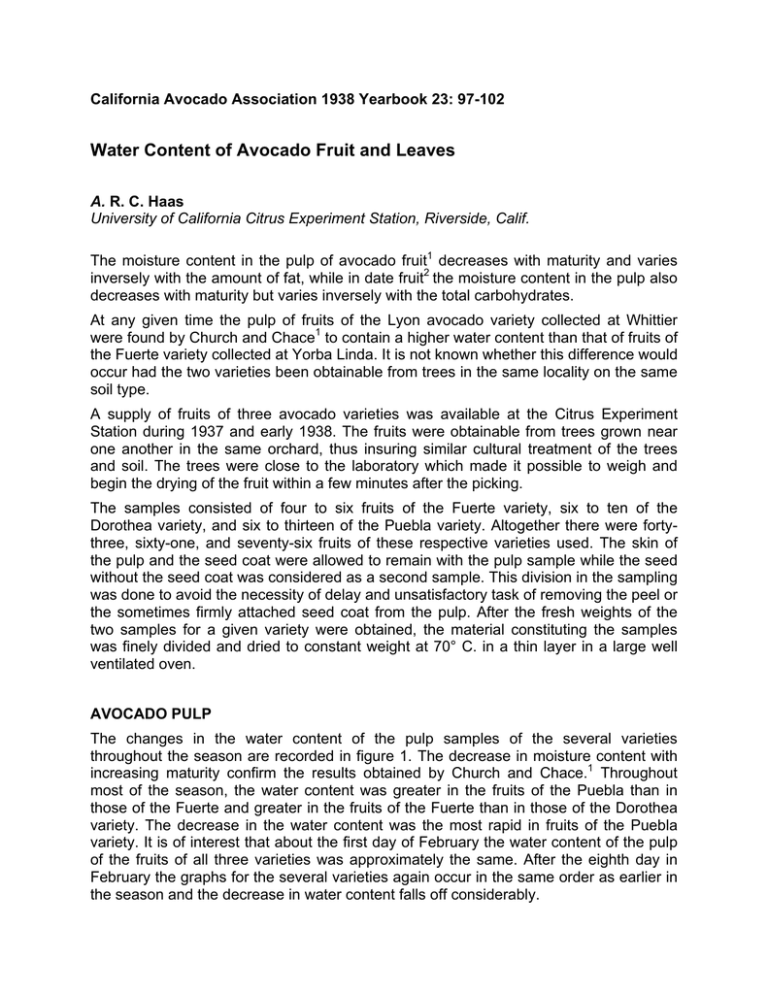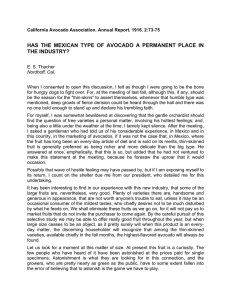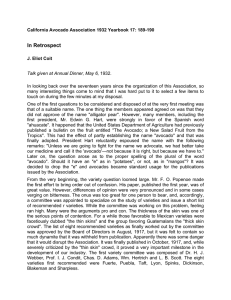Water Content of Avocado Fruit and Leaves
advertisement

California Avocado Association 1938 Yearbook 23: 97-102 Water Content of Avocado Fruit and Leaves A. R. C. Haas University of California Citrus Experiment Station, Riverside, Calif. The moisture content in the pulp of avocado fruit1 decreases with maturity and varies inversely with the amount of fat, while in date fruit2 the moisture content in the pulp also decreases with maturity but varies inversely with the total carbohydrates. At any given time the pulp of fruits of the Lyon avocado variety collected at Whittier were found by Church and Chace1 to contain a higher water content than that of fruits of the Fuerte variety collected at Yorba Linda. It is not known whether this difference would occur had the two varieties been obtainable from trees in the same locality on the same soil type. A supply of fruits of three avocado varieties was available at the Citrus Experiment Station during 1937 and early 1938. The fruits were obtainable from trees grown near one another in the same orchard, thus insuring similar cultural treatment of the trees and soil. The trees were close to the laboratory which made it possible to weigh and begin the drying of the fruit within a few minutes after the picking. The samples consisted of four to six fruits of the Fuerte variety, six to ten of the Dorothea variety, and six to thirteen of the Puebla variety. Altogether there were fortythree, sixty-one, and seventy-six fruits of these respective varieties used. The skin of the pulp and the seed coat were allowed to remain with the pulp sample while the seed without the seed coat was considered as a second sample. This division in the sampling was done to avoid the necessity of delay and unsatisfactory task of removing the peel or the sometimes firmly attached seed coat from the pulp. After the fresh weights of the two samples for a given variety were obtained, the material constituting the samples was finely divided and dried to constant weight at 70° C. in a thin layer in a large well ventilated oven. AVOCADO PULP The changes in the water content of the pulp samples of the several varieties throughout the season are recorded in figure 1. The decrease in moisture content with increasing maturity confirm the results obtained by Church and Chace.1 Throughout most of the season, the water content was greater in the fruits of the Puebla than in those of the Fuerte and greater in the fruits of the Fuerte than in those of the Dorothea variety. The decrease in the water content was the most rapid in fruits of the Puebla variety. It is of interest that about the first day of February the water content of the pulp of the fruits of all three varieties was approximately the same. After the eighth day in February the graphs for the several varieties again occur in the same order as earlier in the season and the decrease in water content falls off considerably. Although early in the season the water content as a per cent of the fresh weight in fullgrown fruits may range above 80 per cent, the percentage of water in well-matured fruits approximates that in mature leaves and suggests a similarity of origin of the fruit and leaves. In any study of trees it is important not only to consider leaves and fruits by themselves but also their relation one to the other. The leaves of certain varieties of citrus trees, when under stress for water, are able to withdraw water from the fruits. When inorganic elements in citrus trees become deficient, the leaves can obtain a supply of the needed element by withdrawing it from the fruits. While fruits remain green, they can assist in the manufacture of foods as well as store the excess foods elaborated by the leaves. The surface layers of cells in fruits, as well as in leaves, may contain openings called stomata which function as pores for the exchange of gases and water between the internal and external atmospheres. Avocado fruits are unique in their ability to contain large quantities of oil and in this respect differ from the leaves. The skins of avocado fruits may accumulate high concentrations of chlorine. When such accumulations occur in avocado leaves, they contribute largely to the condition commonly known as "tip-burn." These are only a few of the possible similarities or differences. AVOCADO SEED The data for the samples consisting of the seed (without the seed coat) were plotted and are shown in figure 2. The per cent of water in the seed of the fruit of the Fuerte variety was usually greater than in those of fruits of the other two varieties tested. The relative uniformity in the per cent of water in the seed of full-grown fruits at various stages of maturity is seen in figure 2. As far as water content may be used as a criterion, it appears that the seed may be considered mature once the fruit has reached full size. If the data for the fruit samples are calculated to the basis of a single fruit, we obtain the results given in table 1. It should be stated that when these fruits were picked no thought was given to the possible calculating of the results on a per fruit basis and hence no desire existed other than to use healthy appearing fruits with attention given to avoid the use of scarred or checked fruits or fruits affected with sun-blotch. The fresh weight of the pulp per fruit of the Fuerte variety is seen to increase for some time before falling off. The dry matter with one exception increases with the progress of the maturity. It is of interest that the weight of the water per fruit increases at first and then falls off. In the seed the variations are such as to show no definite trend, indicating early maturity of the seed; in fact, on February 1 some of the seeds showed germination in the fruit. On January 18, after a rain, free water exuded as drops from the cut pulp when the fruit was opened. For those desirous of learning more about the botanical, physiological, or evolutionary relation of leaves and fruits, a few terms or definitions may point the way. A fruit is a matured ovary, together with accessory parts, and consists of one or more carpels. A carpel has primarily two distinct regions: (1) ovary, which encloses the ovule, and (2) style, which bears the stigma for the reception of pollen. A carpel is a megasporophyll or, in other words, a sporophyll that bears the female reproductive organs. Sporophylls (Greek phyllon, meaning leaf) resemble reduced foliage leaves in which the ovules replace portions or all of the leaf. The pulp of fruit of the Dorothea variety increased in fresh and dry weight and water content for some time and then decreased. There were some indications of this phenomenon also in the seed. On January 18, free water also was seen next to the seed. The values per fruit of the Puebla variety (with the exception of the November picking), show an increase in the fresh weight of the pulp which is followed by a decrease. The water in the pulp per fruit shows a marked increase after January 18, and falls off after February 8. These results on a per fruit basis differ quite markedly from those calculated on a percentage basis as given in figures 1 and 2. The data in table 1 make it appear possible that avocado fruits may increase in size by thinning in the fairly late stages of maturity or that growth of the fruit continues until practically full maturity is reached. Further study is necessary regarding the change in the weight of water in the pulp of a single fruit with the state of maturity of the fruit, for it is known that as water disappears from fruit, it is displaced by some other storage material related to the state of maturity. AVOCADO LEAVES The numerous varieties of avocado trees grown under the same uniform cultural conditions at the Citrus Experiment Station, afforded excellent leaf material with which to study the water content of avocado leaves. The freeze of the early months of 1937 severely injured the Guatemalan varieties. The injured trees were not pruned prior to the taking of the samples. A series of leaf samples were taken on December 31, 1937, and again on January 5 and 6, 1938, from trees of the more common varieties; while on January 12, 1938, samples were taken from trees of the less common varieties. The samples were collected during the period in which the leaves were considered as being mature. The leaves, consisting of petiole and blade, were collected as rapidly as possible and were quickly wiped free of dust and weighed, after which they were dried to constant weight in a large, well-ventilated oven at 70° C. In some cases leaf samples were taken from more than one tree. Table 2 gives the water content of several collections of mature leaves of many varieties of avocado trees. The leaves of the Guatemalan varieties Anaheim, Nabal, Queen, and Dickinson contained the highest water content in the two collections. In the first collection, three of the four Mexican varieties contained the least water. The Ganter (a Mexican variety) was found associated with the group of four intermediate varieties. In the collection made on January 5, the data for the leaves of the Ganter and Fuerte varieties show positions similar to those of December 31. In the collection of January 6, the Fuerte variety is found among the Mexican group. The samples collected on January 12, show relatively high water content of certain tender varieties, which showed injury during the cold season of the winter before the samples were taken. INTERESTING INDICATIONS OF FROST RESISTANCE Although hardiness in plants is the integration of a large number of plant and environmental factors, it is possible to see in the data of table 1 some hint of a relation of the more hardy varieties to their water content. Leaf samples have been preserved for later sugar analyses. Other things being equal, the more water in leaves the more easily the freezing can take place. The 14th Annual Report3 of the General Manager of the Calavo Growers of California for the year ending September 30, 1937, gives the results of surveys of tree damage resulting from the freeze as showing that Mexican seedlings were practically unhurt even at 18°; that trees of the Fuerte and Puebla differed but little in resistance, and that trees of varieties such as Dickinson, Queen, and Anaheim were among the least resistant to frost. It is also urged that varieties should not be planted because of their productiveness regardless of their frost resistance and that plantings should be made of varieties that will withstand colder temperatures. The results of the study of the water content may be of importance in the resistance of avocado trees to low temperatures. 1. Church, C. Q., and E. M. Chace. Some changes in the composition of California avocados during growth. U.S.D.A. Bul. 1073:1-22. 1922. 2. Haas, A. R. O., and D. E. Bliss. Growth and composition of Deglet Noor dates in relation to water injury. Hilgardia 9: 295-344. 1938. 3. Fourteenth Annual Report of the Calavo Growers of California, for the year ending September 30. 1937. 28 pp.


